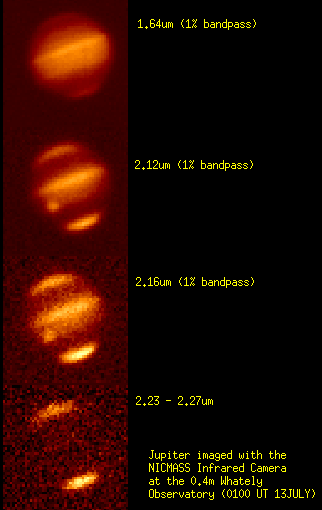

This 1.64 5m image of Jupiter is the result of observations taken at the Whately Observatory on July 13, 1994 UT at wavelengths of 1.64 5m, 2.12 5m, 2.16 5m, and 2.23 - 2.29 5m. These observations were obtained so that there are reference images of Jupiter before its atmosphere is disturbed by the impacts.
The main objective is to monitor the changes in the appearance of Jupiter at a
wavelength of 2.26 Ám. At visible wavelengths, light from the Sun can pass
through Jupiter's upper atmosphere, reflect off of cloud particles, and emerge
again through the upper atmosphere to be seen by a distant observer. At certain
wavelengths in the infrared, particularly between 2.2 and 2.4 Ám, methane and
molecular hydrogen in Jupiter's atmosphere strongly absorb the incident sunlight
-- long before it can penetrate through the atmosphere to reflect off of the
clouds. As a result, Jupiter reflects virtually no sunlight at certain
near-infrared wavelengths, making it appear nearly pitch-black to an observer
working at these wavelengths. Our expectation is that the impacts of the
fragments of comet SL-9 will stir particles high enough into the atmosphere so
that sunlight can reflect off of them before being absorbed. Jupiter may develop
a bright spot near the impact site that will be spread around the planet as a
belt by the global winds.
![]() Images, Images, Images
Images, Images, Images
